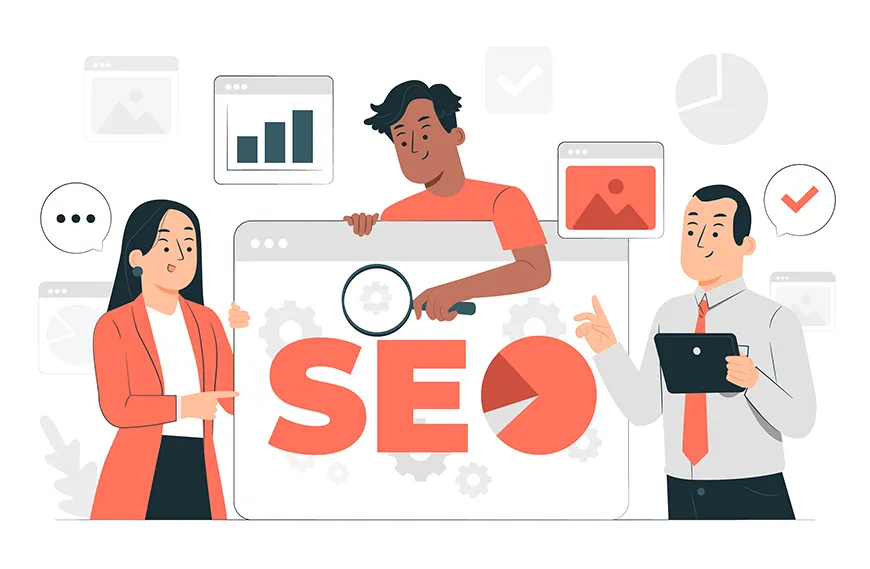Today, many people have realized that with the help of the Internet, digital marketing methods, and search engines such as Google, they can grow and expand their businesses in the best way possible and achieve success and desired income. One of the best and most effective ways to increase sales on the Internet is to launch a website and SEO it. The SEO process, or search engine optimization, helps your website be found better in search engine results, including Google.
In this article, we intend to fully explain the important concepts of SEO and point out the necessary tips for your website to be seen on Google. Stay tuned.
What is SEO?
SEO stands for Search Engine Optimization; It means optimizing the website based on the rules of search engines like Google to reach high ranks in search results. Its purpose is to produce and optimize content in a way that helps visitors and search engine crawlers find the answers to their key questions in the best way.
Our goal in SEO is to increase the volume of high-quality, reliable, and valuable content. By improving your website content and adapting it to the needs of users and search engine algorithms, including Google’s, you increase the amount of traffic that your web content receives from search engines every day.
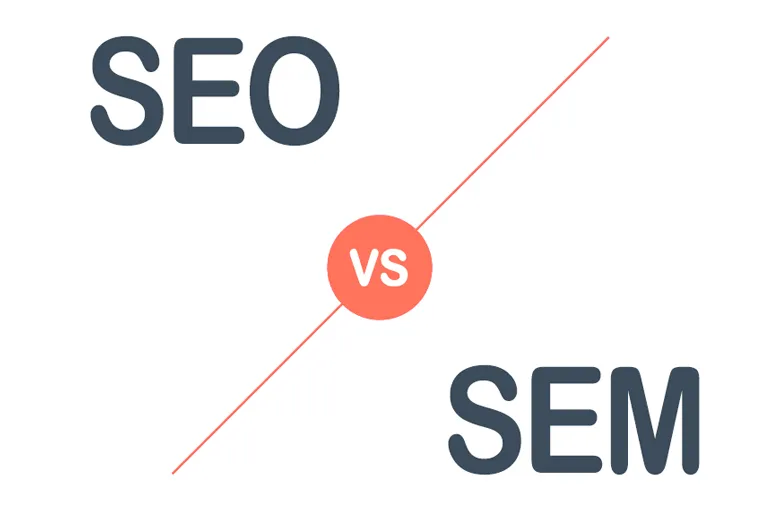
SEO vs. SEM: What’s the Difference?
SEO and Search Engine Marketing (SEM) are among the marketing strategies that businesses use to better reach their target audience through Search Engine Results Pages (SERPs). The main difference is that SEO focuses on optimizing pages to rank better through organic traffic, while SEM (Search Engine Marketing) uses paid strategies (such as Google Ads) to increase website traffic in search engines.
With SEO, it takes some time to achieve consistent and lasting results; But SEM provides an almost immediate result. Despite being different, SEO and SEM are closely related; A good SEO foundation is essential to a successful SEM strategy.
What factors affect search engine optimization and are the most important?
Google, as the main search engine, processes over 6.5 billion searches daily. By optimizing your website for Google, you can transfer a lot of daily traffic to your website. For this reason, it is essential to pay close attention to Google’s ranking factors. These factors are constantly changing along with Google’s algorithms, and their goal is to provide the most relevant content to users.

In the following, we intend to describe some of the most important Google search engine ranking factors.
Page Speed
Page speed refers to the amount of time it takes for a web page to load. Regularly monitor the performance of your website and use speed analysis tools such as Google’s PageSpeed Insights, GTmetrix, and Pingdom Speed Test to get an accurate estimate of your website’s performance.
Mobile Compatibility
Responsive design automatically adjusts website elements to fit different screen sizes, providing an optimal experience for visitors on all devices. Responsive and mobile-friendly website pages are shown higher in search results.
Quality Content
In your content, provide relevant and accurate information to answer specific questions. Google evaluates length, structure, relevant keywords, and content information. Always look to create unique content to attract more visitors and increase your website traffic.
Backlinks
Backlinks are actually links to your website that are placed on other websites and act as an indicator of the credibility of your website. When a website places your link in its content, it introduces your website as a related source to Google. Pages that have quality backlinks from reputable websites can rank higher in search engine results pages.
User Experience
Google measures user experience (UX) through multiple signals, including bounce rate and time spent on page. When visitors enter a website and immediately leave it, Google considers this as a negative signal. As a result, if visitors stay on the website for a while and interact with it, it shows that the website is conveying valuable information. Also, following the principles of Core Web Vitals plays an important role in improving the user experience (UX).
Website Security
Includes all measures to protect a website and its visitors from cyberattacks; So Google prioritizes websites that are secured with HTTPS (Hypertext Transfer Protocol Secure). If a website has security issues, users will avoid it. Security is a top priority for every web user, so adding an SSL certificate to your website is considered essential.
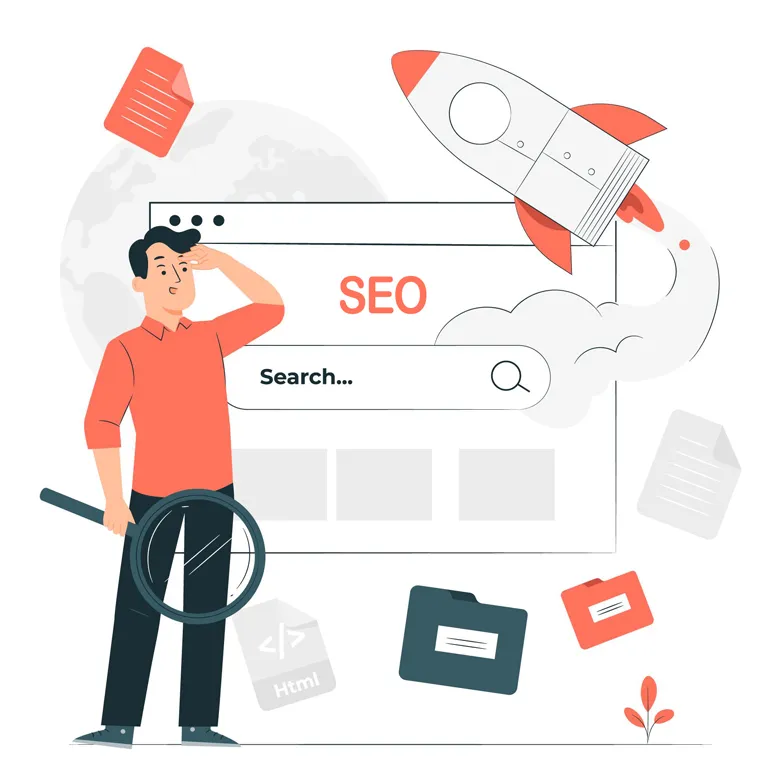
How does SEO work?
Google and other search engines work to collect, organize, and display relevant information to answer user queries. To do this, they go through three main processes, which are as follows:
Crawling
Search engines rely on a team of web crawlers, also known as spider bots, to find updated content on the web. Web crawlers help to discover and collect the information needed to index a page.
Indexing
Indexing refers to the process by which search engines store and organize the collected web pages. When web crawlers find information such as keywords and fresh content on a website, they add the web page to the search index.
Ranking
After the indexing process, web pages are displayed in search results from the most to the least relevant content.
SEO or Search Engine Optimization improves the ranking of your website by making it more attractive to search engines. Many factors contribute to improving the indexing and ranking process; for example, well-structured internal links on your pages make it easier for web crawlers to jump from one page to another. If you don’t want certain pages to be ranked by search engines, you can block bots using the robots.txt file.
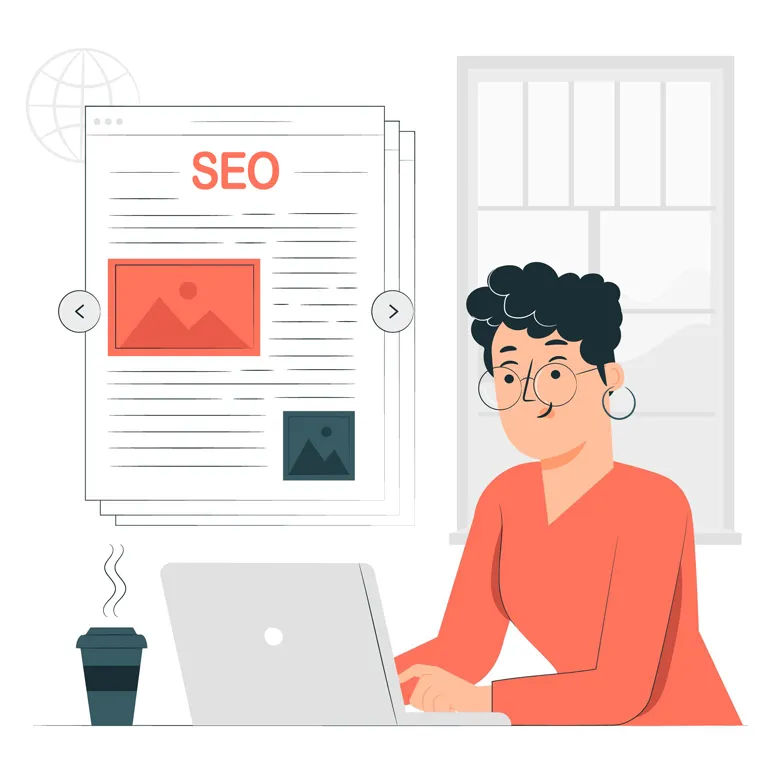
What are the different types of SEO?
Search engine optimization has different types, which we will mention below.
On-page SEO
On-page SEO is the process of optimizing individual pages of a website to improve its ranking in organic search results. This type of SEO focuses on the content of the page and the HTML source code, including title tags, header tags, and meta descriptions. On-page SEO also helps to organize your page so that search engine web crawlers can easily analyze your content and index it for relevant searches.
Some of the most important topics that fall under the category of on-page SEO include:
- Website content: Google uses an algorithm called E-A-T (Expertise, Authoritativeness, and Trustworthiness) to evaluate the quality of content, pages, and websites. Google prefers high-quality content from reputable authors and websites; therefore, to rank higher in search results, you need to make sure your page meets these criteria.
- Keyword optimization: Placing keywords in content helps the search algorithm identify the type of information the content provides. You can use SEO tools like Ahrefs Keywords Explorer or Google Keyword Planner to find the desired keyword and create your content based on it. Make sure the keyword distribution in the content is natural to avoid being penalized by Google.
- Title tag: It appears as a clickable link that people see in search engine results pages and determines the relevance of the page to the user’s search intent. A well-written title will generate more clicks and drive more traffic to the page; Additionally, search engines like Google prefer a concise title with keywords and rank it higher in organic results.
- Heading tags: Dividing content with heading tags provides a better user experience and makes it easier for web crawlers to index your page. When users search for the phrases they are interested in, the search engine uses these tags as a guide to look for relevant information; This increases the chance of your page being displayed higher in search results.
- Image alt text: Alt text is an attribute that describes a specific image that the website cannot display. Screen readers use alt text information to describe the image. This tells the search engine that the image is a valuable piece of content on your page.
- Meta description: Meta is actually a short description on the results page that appears as a small section along with the page title and URL. The meta description includes keywords and accurately describes the information that the page provides. A good meta description can generate more clicks and reduce bounce rate. (Of course, the content itself must be able to consider the purpose of the users)
Off-page SEO
Off-page SEO is another type of search engine optimization that is essential for website optimization. It refers to any activity that is performed outside of a website to improve ranking in search engine results pages. It tells the search engine how well the audience understands a website, business, or product.
A correct strategy in off-page SEO helps the website increase the authority of its pages and get a better rank on the results page. In the following, some of the most important factors that should be considered in this type of SEO will be explained.
- Link building: refers to the process of getting links from other websites to your website. Google’s algorithms rely heavily on links. Every link you receive acts as a vote of confidence for your website. Make sure you get high-quality links; low-quality links not only can’t improve your rankings, but they can also result in Google penalties.
- Social media marketing: A powerful social media presence is important for your business; social media is very important for branding. Posting attractive content on these platforms helps you attract more audience; in addition, when your content manages to attract traffic from all over the world, search engine realizes that your website is trustworthy.
- Influencer marketing: Building relationships with brands or influential people is a great way to increase brand awareness. When done right, influencer marketing can help build brand recognition and attract new audiences to your website.
- Forums: Forum pages like Quora, Reddit, and Stack Overflow provide a great opportunity to promote your website. In forums, you can participate in real-time conversations between users by answering questions, and it gives you the opportunity to show your expertise and credibility; At the same time, you can add a link to a page on your website and increase organic search traffic.
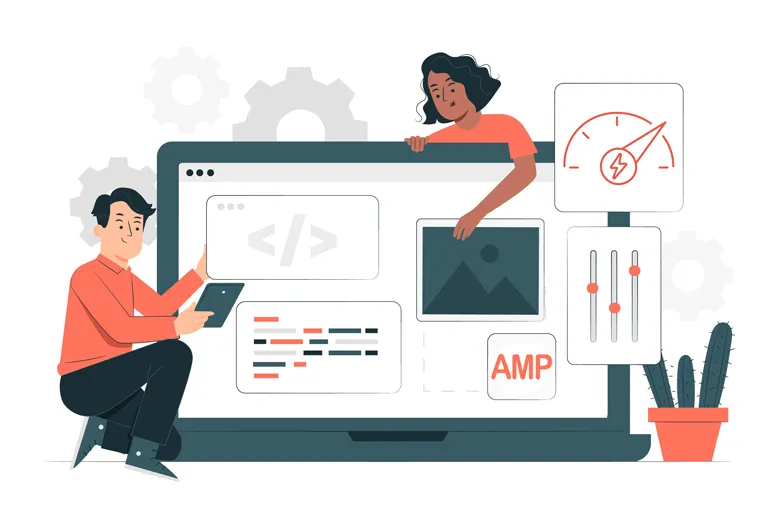
Technical SEO
Technical SEO is the process of optimizing the technical aspects of your website to ensure that it meets the criteria of search engine algorithms. This type of SEO includes optimizing for speed, mobile compatibility, and website architecture.
Technical SEO is the process of optimizing a website’s technical aspects to make it easier for search engines like Google to crawl, index, and understand its content. A website with optimized technical SEO will rank higher in search results. Technical SEO not only helps improve your rankings, but it also provides a better user experience (UX).
Users and search engines both prefer a website with a good structure, fast loading times, and high security. There are several technical SEO factors that you should consider when optimizing your website:
- Page loading speed: A website with pages that take too long to load will have a higher bounce rate and a worse ranking. Steps like caching the website, compressing images, and reducing redirect pages are some effective ways to optimize speed. Additionally, you can use tools like GTmetrix and PageSpeed Insights to determine which components to optimize.
- Schema: refers to labels that you can add to your HTML code to help search engines better understand your content. Adding schema helps your pages show up better in search results.
- Internal linking: The process of attaching hyperlinks to other pages on the same website. By placing internal links, search engine crawlers can find and index more pages on your website. When internal links are implemented correctly, they can improve page authority and increase page time.
- XML Sitemap: An XML sitemap is a list of all the URLs on your website. It acts as a roadmap for search engine crawlers, allowing them to quickly find important pages. The Yoast SEO plugin provides an easy way to create an XML sitemap in WordPress SEO. Alternatively, you can use free tools like InSpyder or Screaming Frog.
- Accelerated Mobile Pages (AMP): When you enable AMP, Google delivers your web pages through a designated cache, allowing your website to load faster. Google also prioritizes AMP websites and considers this capability an important factor in determining a high-quality website.
- SSL certificate: A website with SSL encryption enables HTTPS in its URL. This feature indicates that any information transferred between a website and its users is secure and encrypted. Since Google uses HTTPS as one of its ranking factors, enabling it means that your website can achieve higher search rankings. If your hosting service has an SSL certificate, make sure to enable it.

Local SEO
Local SEO is the practice of improving the visibility of local businesses in search results. This type of search engine optimization allows businesses to better promote their brands, products, and services to local communities.
When people search for terms like “doctors near me” or “restaurants near me,” search engines identify their locations through IP addresses and provide relevant results based on that. To gain a position in local search results, you need to optimize your local SEO.
Google offers local search results with a map along with three organic search results. For example, when users search for “Restaurants in New York,” the results page shows three local businesses as top results along with their locations on Google Maps.
If you want to show your business in the local search results, you need to pay close attention to various aspects of local SEO:
Google My Business (GMB) Profile
The map that appears in the top results of Google Local Search comes from GMB profiles. You will need to create an account first. Make sure to enter accurate and complete information such as your name, address, and phone number, as these information act as ranking factors. Additionally, Google ranks a GMB profile based on distance, rating, and relevance to the searched phrase.
Local Keyword Research
If local keyword research is done correctly, you can see an improvement in your ranking on the search results page. Make a list of keywords to describe your products or services. An SEO tool like Ahrefs can help you identify how well keywords perform based on search volume and difficulty.
Local Content
Targeting specific local content can help your website to be seen well in the local context. This type of content should be able to meet the demand of your target audience in the best way. From blog posts and guides to case studies and recommendations, make sure you choose the ones that are relevant to your business niche.
Customer Reviews
Reviews show that customers trust your business and Google will take notice of that fact; therefore, start encouraging your customers to leave reviews. You can do this by sending them an email or providing a review page.

Best practices for SEO success
SEO success methods are diverse. Using the wrong and outdated strategies can not only damage your ranking, but can also affect your website traffic. Read on to learn about the optimal methods for achieving positive results from SEO.
Keyword Research
Keyword research is essential for search engine optimization, so it’s important to know what it is and how to do it effectively. First, you need to be familiar with the different types of keywords:
- Seed: These keywords, which define your niche, are the foundation for developing your website content and are known as focused keywords.
- Synonyms: Keywords can have the same meaning but different structures and attract similar search results. For example, the phrase “how to fix broken headphones” can be changed to “how can broken headphones be fixed.”
- Long-tail: Long-tail keywords are longer, more specific phrases that answer a specific search query. Long-tail keywords are made up of three or more keywords, such as “gluten-free chocolate chip cookie recipe.”
- Semantic: These keywords are related to each other conceptually. For example, “visiting New York” is semantically related to “flight tickets to New York” and “best destinations in New York.”
The key to SEO optimization with keyword research is to target a topic relevant to your industry that has good traffic potential while also considering the following criteria:
- Search volume: This determines how many people are searching for a specific phrase at a given time.
- Keyword difficulty: This metric, also known as keyword competition, measures the difficulty of ranking a keyword in Google’s organic search results.
Fortunately, SEO tools like Ahrefs, SEMrush, and Google Keyword Planner can easily identify these metrics. Typically, a keyword with high search volume will attract more organic search traffic, but it is also more competitive. Targeting high-volume keywords means competing with high-quality websites that have higher authority.
On the other hand, long-tail keywords have less competition and allow you to create content that is very relevant to your audience. Start by improving your website traffic through long-tail keywords and build your strategy on that foundation.

Match your content with the search intent
Google’s algorithms help to provide better search results for users based on their search intent. For example, Google’s algorithms not only provide relevant search results to users, but they can also determine their search intent.
When a user searches for the phrase “how to sync a JBL Bluetooth speaker,” Google returns results from pages or videos that contain instructions. Meanwhile, when a user searches for the phrase “buy JBL Bluetooth speaker,” Google immediately displays shopping pages as the top results.
The reason for this in SEO is that Google’s algorithms can identify four main search intents and act accordingly.
- Informational: Searches that are conducted with the purpose of learning. These searches often include phrases with “how,” “who,” or “what,” but are not limited to these terms.
- Navigational: Searches that are looking to visit specific websites. In this case, users choose to navigate through Google instead of typing the URL into their address bar. Some examples of searches for this purpose include: “Reddit,” “Spotify,” and “Facebook.”
- Commercial: These searches are typically conducted before a purchase. Users will research and compare multiple brands, products, or services to find the best option. A common query for this search purpose could be “Gaming laptops 2025” or “Best restaurants near me.”
- Transactional: These searchers are targeting a specific product or service for purchase. Searches typically include brand names, such as “buy Samsung Galaxy S24.”
With these things in mind, the best SEO method is to produce your content according to different target types; In short, figure out what your users want and respond to them.

Put your target keyword in the title tags
Title tags are very important for a website; they give users a glimpse of the content and help them understand why the content is relevant to their search. Users are always looking for pages that show relevant keywords to their requests; that’s why Google wants you to choose good titles for search results.
When you optimize a title with a target keyword, you give search engines more opportunities to discover your website and rank better. One important thing is to put your main keyword at the beginning of the title; this can not only attract the attention of users, but also help search engines determine what the page is about.
In addition to optimizing title tags, meta descriptions are also very important. Here are a few SEO tips to keep in mind: keep the meta description around 150 characters and mention important and useful information in it.
Get authorized backlinks
Authorized backlinks are links that are received from reputable websites. Google sees backlinks as a vote of confidence in your website and considers the authority of the source domain to validate them. Having the right number of authorized and quality backlinks has more benefits than having too many links from spam websites.
High-quality backlinks help your SEO ranking, while low-quality backlinks can harm your website’s authority. Here are some SEO tips to build quality backlinks to your website:
Write quality content: Providing comprehensive and valuable content on a website is essential. This helps other websites to judge your credibility and determine whether your page is worth linking to.
Guest post: Refers to writing a blog post for another website. In return, they allow you to add backlinks in the post or author bio section. This helps you to build brand awareness and also drives more organic traffic to your website.
Analyze your competitor’s backlinks: This monitoring helps you to identify websites that are likely to link to your website. Tools like Monitor Backlinks and Ahrefs Link Intersect allow you to identify these backlinks. Once you find the websites that link to your competitor, negotiate with the owners of these websites and make your offer.

Why SEO is important?
Organic search has become an important part of online marketing, accounting for around 53.3% of total website traffic. Organic traffic has the potential to convert visitors into buyers or members of your business; however, it is not easy to drive organic traffic to your website, and that’s where SEO comes in.
By focusing on search engine optimization (SEO), you can optimize different parts of your website for the various criteria of search engine algorithms. SEO provides a set of strategies that focus on increasing website traffic in search engines by following On-page and Off-page SEO, and technical SEO principles. The higher your rank, the more traffic your website will receive.
First image by Freepik
Third image by Freepik
Fourth image by Freepik
5th image by Freepik
6th image by Freepik
7th image by Freepik
8th image by Freepik
9th image by Freepik
11th image by Freepik
